Compounds and methods for the treatment of EGFR positive diseases
a technology of egfr and compounds, applied in the field of compounds and methods for the treatment of egfr positive diseases, can solve the problems of high and often unacceptable toxicity, and achieve the effects of preventing recurrence of egfr-positive cancer, reducing the undesirable side effects of maytansinoid, and reducing the toxicity
- Summary
- Abstract
- Description
- Claims
- Application Information
AI Technical Summary
Benefits of technology
Problems solved by technology
Method used
Image
Examples
example 1
Esterification of Maytansinol with Fmoc-N-methyl-L-alanine (Fmoc-N-Me-D / L-Ala-MDC)
[0188]
[0189]A mixture of maytansinol (0.600 g, 1.062 mmol), Fmoc-N-Me-L-Ala (6.911 g, 21.24 mmol), Sc(OTf)3 (0.314 g, 0.637 mmol) and DMAP (0.389 g, 3.186 mmol) in CH2Cl2 (100 mL) was stirred for 0.5 h at −8° C. DIC (2.949 g, 23.37 mmol) was added dropwise, stirred for 0.5 h, warmed to r.t. slowly, filtered to recover the Lewis acid catalyst, the filtrate was quenched with diluted HCl and extracted with CH2Cl2. The combined organic phase was washed with NaHCO3 aq, brine, dried over anhydrous Na2SO4. The solvent was removed under reduced pressure. Chromatography (silica gel, CH2Cl2 / MeOH 30:1) gave the desired product as a mixture of diastereomer Fmoc-N-Me-D / L-Ala-MDC: white solid (0.8385 g, 90.5%). Further column chromatography (silica gel, CH2Cl2 / MeOH 100:1 to 20:1) gave two fractions as pure diastereomer. The higher Rf fraction was determined to be the D-aminoacyl ester diastereomer (Fmoc-N-Me-D-Ala-M...
example 2
Deprotection of Fmoc-N-Me-D / L-Ala-MDC (N-Me-D / L-Ala-MDC)
[0190]
[0191]Into Fmoc-N-Me-D / L-Ala-MDC (0.463 g, 0.5307 mmol) in ACN (200 mL) was added piperidine (0.865 g, 10.15 mmol). The mixture was stirred at r.t. for 4 h, quenched with water and extracted with CH2Cl2. The combined organic phase was washed with brine and dried over Na2SO4. The solvent was removed under reduced pressure to give the crude product, which was used in the next step without further purification. LC-MS (M+H+) calc.: 650.3. found: 650.3. Rt: 3.96 min.
example 3
Deprotection of Fmoc-N-Me-L-Ala-MDC (N-Me-L-Ala-MDC)
[0192]
[0193]Into Fmoc-N-Me-L-Ala-MDC (0.463 g, 0.5307 mmol) in ACN (200 mL) was added piperidine (0.865 g, 10.15 mmol). The mixture was stirred at r.t. for 4 h, quenched with water and extracted with CH2Cl2. The combined organic phase was washed with brine and dried over Na2SO4. The solvent was removed under reduced pressure to give the crude product, which was used in the next step without further purification. LC-MS (M+H+) calc.: 650.3. found: 650.3. Rt: 3.96 min.
PUM
| Property | Measurement | Unit |
|---|---|---|
| molecular weight | aaaaa | aaaaa |
| concentrations | aaaaa | aaaaa |
| concentration | aaaaa | aaaaa |
Abstract
Description
Claims
Application Information
 Login to View More
Login to View More - R&D
- Intellectual Property
- Life Sciences
- Materials
- Tech Scout
- Unparalleled Data Quality
- Higher Quality Content
- 60% Fewer Hallucinations
Browse by: Latest US Patents, China's latest patents, Technical Efficacy Thesaurus, Application Domain, Technology Topic, Popular Technical Reports.
© 2025 PatSnap. All rights reserved.Legal|Privacy policy|Modern Slavery Act Transparency Statement|Sitemap|About US| Contact US: help@patsnap.com



